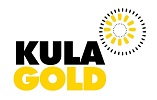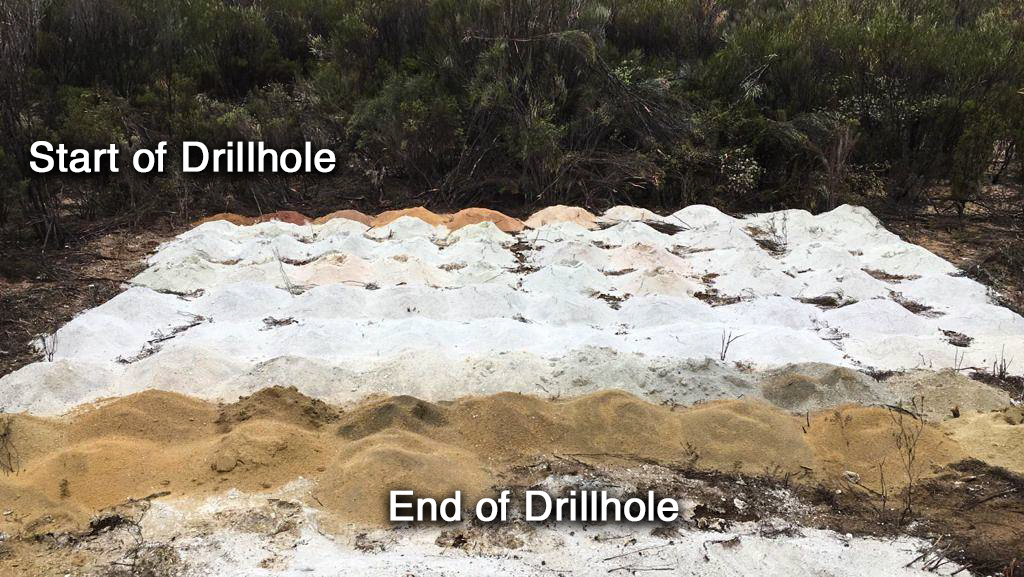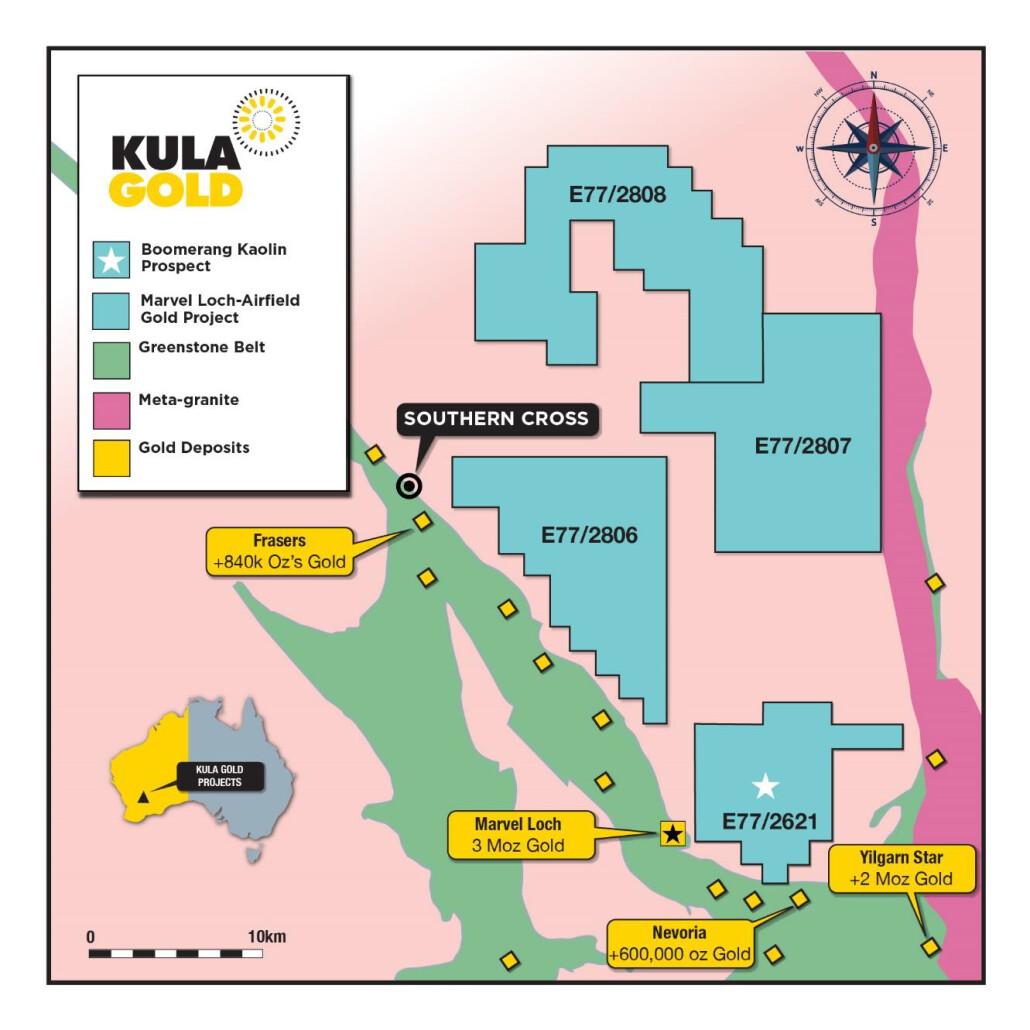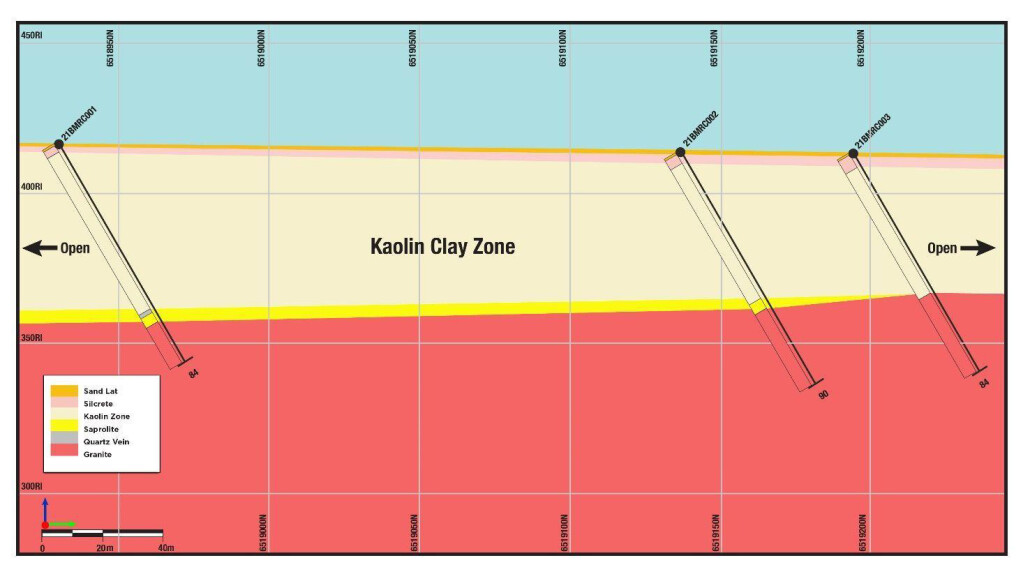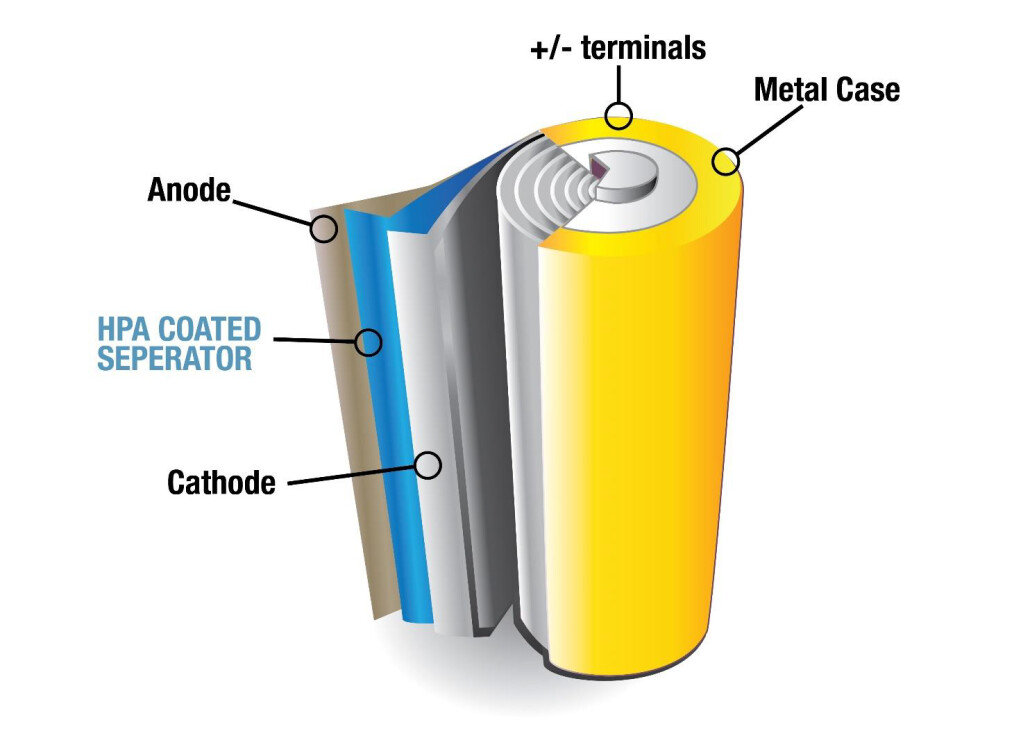⛏️ Kula Gold Limited reports that that RC drilling at the Airfield Gold Project near Southern Cross WA, intersected thick >42m vertical kaolin clay development over the 300m drilled length at the newly named Boomerang Kaolin Prospect. An RC Drilling Program is planned to define and test the extents of the kaolinized zone in August.
HIGHLIGHTS:
• Drillhole 21BMRC001 intersected 10m @ 7% Halloysite from 40m depth downhole (8.8m true thickness) within an intersection of 55m of kaolin downhole;
• All three RC holes intersected +42m average vertical thickness white kaolin clays near the centre of the licence- (the Boomerang Kaolin Prospect) only 5m from surface;
• Initial lab sample analysis confirms high ISO brightness, high kaolin % and low impurities;
• HPA sighter leach test in progress;
• RC drill rig secured for immediate resource definition drilling program commencing this quarter.
The holes were drilled to test a magnetic anomaly and intersected the deep white kaolin zone shown in Figure 2.
A total of 28 five metre composite samples were sent to Bureau Veritas (“BV”) in Adelaide for sieving, XRF and ISO brightness analysis.
The samples were wet sieved to remove quartz and mica to produce a coarser -180µm +45µm fraction and a finer -45µm fraction which were both assayed by XRF.
The -45µm samples were then sent to CSIRO for XRD analysis to determine the kaolin-halloysite content.
The results have been received and are shown in Table 1. A sighter HPA leach test is in progress for the Boomerang Kaolin Project.
Results for the 28 Boomerang composite kaolin samples show approximately 47% of the sample reports to the -45µm fraction which grades 37% Al2O3 with very low levels of impurities (Fe2O3 and TiO2) and high ISO brightness results. Results are very consistent across the three drill holes, and comparable to some of the higher quality deposits in the industry, albeit early stage as only three holes have been drilled to date.
SUMMARY AND NEXT DRILLING PROGRAM
The bright white kaolin zone was discovered when drilling a geophysical based gold target in April this year (See Figure 2 above).
A 200m spaced RC drilling program (2000m) is planned to define and test the extents of the kaolinized zone above the granite in August. The company believes the Exploration Target is between 30 and 100Mt of kaolin material based on the current thickness and the nature of the process that forms the wide zones of kaolin in weathered granite. Drill testing will continue if wide zones are intercepted in the planned program. The target size is conceptual in nature and there has been insufficient exploration to estimate a mineral resource at this stage. Only three drillholes have been completed over a length of approx. 300m to date and it is uncertain if further exploration will result in the estimation of a mineral resource.
The planned RC drilling is expected to be efficient given the spacing, and soft shallow profile. Drillholes will also be extended a further ~10m into fresh rock to test for gold below the kaolin on potential geophysical targets. Additional areas where the previous auger drilling identified bright white kaolin clays near surface are also planned to be RC drilled to verify the thickness of the kaolin clays.
The Boomerang Kaolin prospect lies in a favourable location, being ~25km from the Kalgoorlie water pipeline and Highway 94 Perth to Kalgoorlie, and 42km to the Southern Cross Rail yard.
The Company notes recent results from Western Australian Kaolin and Halloysite explorers, Andromeda Metals Ltd (ASX:ADN), Suvo Strategic Minerals Limited (ASX:SUV), Latin Resources Limited (ASX: LRS), FYI Resources Limited (ASX:FYI), WA Kaolin (ASX:WAK) & Alpha HPA Ltd (ASX:A4N). Recent prices for Kaolinite end product have been quoted/published at up to $700/t. Higher grade Halloysite and some applications in the High Purity Alumina (HPA) sector can achieve prices as high at $30,000/t with further processing. Further details on the world kaolin market are attached at Appendix 1.
Whilst Kula’s results are preliminary and need to be confirmed by follow up drilling and assays, the Company believes that the initial assays are significant in grade and extent and require further investigation and drilling.
APPENDIX 1
Nature and Occurrence – World Markets for Kaolin.
Kaolin is a white, soft, plastic clay composed mainly of kaolinite, Al4(OH)8[Si4O10], and other related clay minerals such as nacrite and dickite (Baker & Uren 1982). Primary kaolin tends to be well-ordered, with a high degree of crystallinity, forming a dense texture of semi-plastic clay. It forms in response to anhydrous aluminium silicate alteration in feldsparrich rocks by weathering or hydrothermal processes.
Many kaolin deposits have been significantly upgraded by post-depositional weathering and diagenesis that have removed much of the original impurities — such as carbonaceous material and iron minerals — and have allowed extensive recrystallisation of the kaolinite to take place. Kaolin is produced by more than 50 countries.
The main exporters of refined (filler-grade) kaolin for high-quality markets, including paper, plastics and paints, are the USA, Great Britain, Brazil, and Germany. Major suppliers of low-to medium-quality kaolin used in applications such as refractories and ceramics include China, Colombia, South Korea, Uzbekistan and Ukraine.
Halloysite.
This is similar to kaolinite but with variable amounts of water (H2O) between the layers and composed of long, slender, tube-like crystals as per the diagrams below.
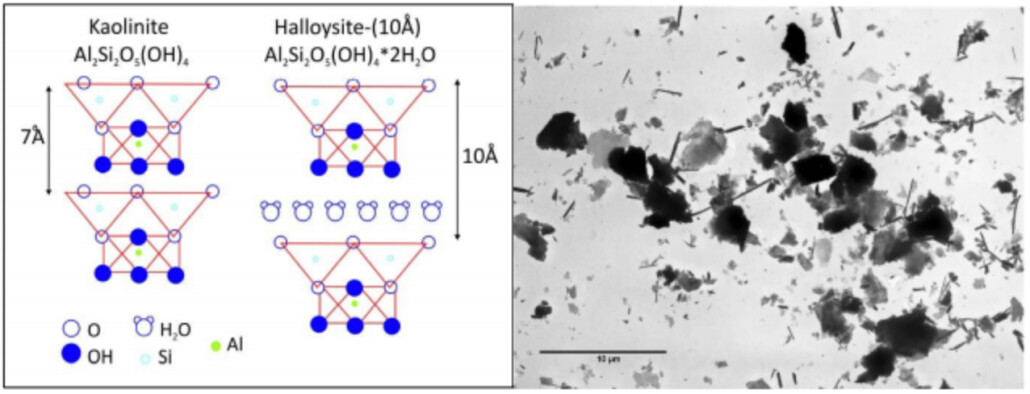
Figure 5. Kaolinite vs Halloysite Structures and an example of platy kaolin and Halloysite tubes in SEM image on right.
Chemically inert, nonabrasive and in possession of a number of characteristics make this commodity highly desirable for use in a broad range of industries including paper and paperboard, ceramics, fibreglass, paints and coatings, plastics, rubber, pharmaceuticals and medical, cosmetics, concrete and agriculture.
High Purity Alumina (“HPA”)
HPA is a non-metallurgical premium alumina product characterised by a minimum purity of 99.99% (4N). It is produced from Kaolin processing it through a variety of metallurgical processes to produce a 4N product.
HPA is used as a base material in the manufacture of a variety of products including:
• Light Emitting Diodes (LED’s);
• Electronic displays;
• Separator between cathode and anode in EV and rechargeable batteries -specifically the growing EV market. This is a highly important consideration for EV batteries, as HPA purity is critical to prevent battery ageing.
HPA demand is forecast to increase substantially in the next decade.
View the Full ASX Release here: Southern Cross-Airfield RC Drilling Discovers +42m Vertical Thickness High Quality Kaolin Clays near surface.
– News Release –
Date: 13 July 2021 | ASX Code: KGD
Cautionary Statement: Forward Looking Statement: This announcement may include statements that could be deemed “forward-looking statements”. Although Kula Gold Limited (the Company) believes the expectations expressed in such forward-looking statements are based on reasonable assumptions, such statements are no guarantee of future performance and actual results or developments may differ materially from those expected in the forward-looking statements or not take place at all.
No offer to sell or invitation to buy: This announcement is not, and should not be considered to, constitute any offer to sell, or solicitation of an offer to buy, any securities in the Company, and no part of this announcement forms the basis of any contract or commitment whatsoever with any person. The Company does not accept any liability to any person in relation to the distribution or possession of this Presentation from or in any jurisdiction.
Disclaimer
Whilst care has been exercised in preparing and presenting this announcement, to the maximum extent permitted by law, the Company and its representatives: • make no representation, warranty or undertaking, express or implied, as to the adequacy, accuracy, completeness or reasonableness of this announcement; • accept no responsibility or liability as to the adequacy, accuracy, completeness or reasonableness of this announcement; and • accept no responsibility for any errors or omissions from this announcement.
About the Company
Kula Gold Ltd (ASX: KGD) is a Western Australia gold exploration company focussed on large land positions and structural geological settings capable of hosting ~1m oz deposits.
The company has projects within the Southern Cross WA region including Marvel Loch, Rankin Dome and Westonia, as well as near Kurnalpi and Brunswick. The company has a history of large gold resource discoveries with its foundation Woodlark Island project in PNG.
Contact the Company Secretary on Tel: +61(08) 6144 0592 or via cosec@kulagold.com.au
